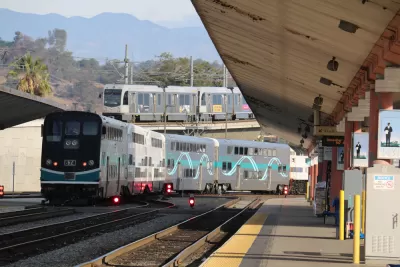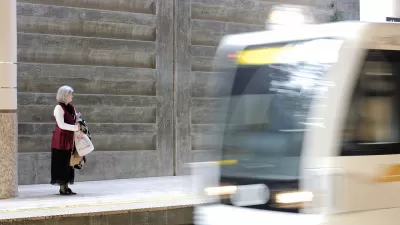New transit lines are usually intended to provide an alternative to driving. But what happens when a new train line provides an alternative to an older train line?

Thousands of Southern California transit users are switching from Metrolink commuter rail to Gold Line light rail, according to an article by Steve Scauzillo. "Both go to Los Angeles but the Gold Line is much cheaper, offers more trains more often and less waiting," according to Scauzillo.
According to a ridership released by Metrolink in July, ridership on the agency's San Bernardino line dropped 7.6 percent between January and March compared to the year prior. In total, the line lost 56,620 riders. Other lines also lost riders numbering in the tens of thousands.
When rail commuters hop from one train service to another, the switch "doesn’t remove cars from the traffic-snarled freeways nor does it reduce air pollution since these commuters weren’t driving anyway." It is, however, creating friction between Metrolink and Metro, which will "only get worse once the Foothill Gold Line Construction Authority builds the next leg from Glendora to Montclair, creating duplication of services at three Metrolink stations: Montclair, Pomona and Claremont," writes Scauzillo.
In response to the conflicting dynamics of the two transit agencies, "heavy rail planners at the Los Angeles County Metropolitan Transportation Authority, or Metro, [have] proposed a $500,000 study on how the two agencies can coexist."
FULL STORY: A tug-of-war between Metro, Metrolink intensifies as thousands switch to cheaper Gold Line

Study: Maui’s Plan to Convert Vacation Rentals to Long-Term Housing Could Cause Nearly $1 Billion Economic Loss
The plan would reduce visitor accommodation by 25,% resulting in 1,900 jobs lost.

Alabama: Trump Terminates Settlements for Black Communities Harmed By Raw Sewage
Trump deemed the landmark civil rights agreement “illegal DEI and environmental justice policy.”

Why Should We Subsidize Public Transportation?
Many public transit agencies face financial stress due to rising costs, declining fare revenue, and declining subsidies. Transit advocates must provide a strong business case for increasing public transit funding.

Paris Bike Boom Leads to Steep Drop in Air Pollution
The French city’s air quality has improved dramatically in the past 20 years, coinciding with a growth in cycling.

Why Housing Costs More to Build in California Than in Texas
Hard costs like labor and materials combined with ‘soft’ costs such as permitting make building in the San Francisco Bay Area almost three times as costly as in Texas cities.

San Diego County Sees a Rise in Urban Coyotes
San Diego County experiences a rise in urban coyotes, as sightings become prevalent throughout its urban neighbourhoods and surrounding areas.
Urban Design for Planners 1: Software Tools
This six-course series explores essential urban design concepts using open source software and equips planners with the tools they need to participate fully in the urban design process.
Planning for Universal Design
Learn the tools for implementing Universal Design in planning regulations.
Smith Gee Studio
Alamo Area Metropolitan Planning Organization
City of Santa Clarita
Institute for Housing and Urban Development Studies (IHS)
City of Grandview
Harvard GSD Executive Education
Toledo-Lucas County Plan Commissions
Salt Lake City
NYU Wagner Graduate School of Public Service



























